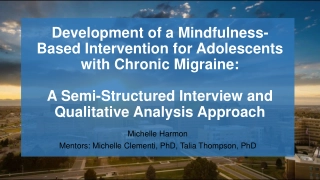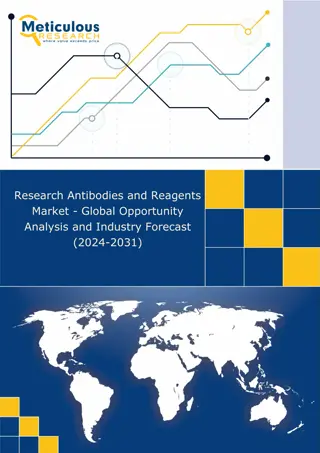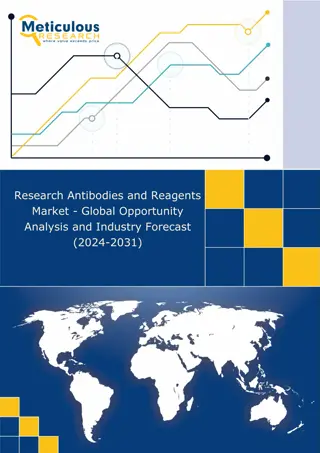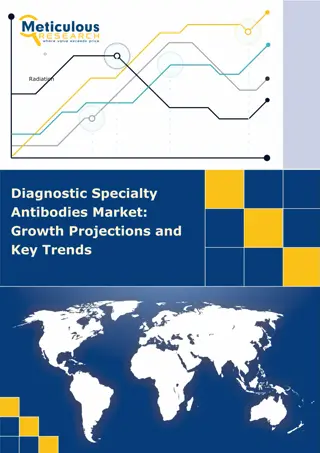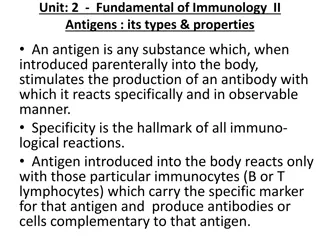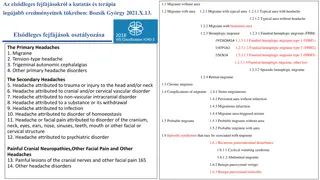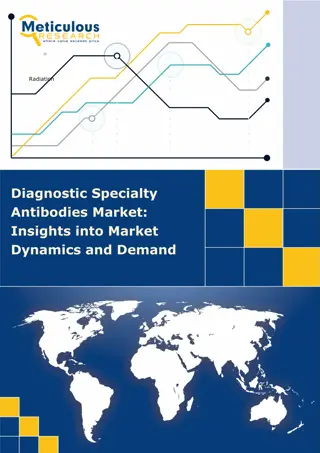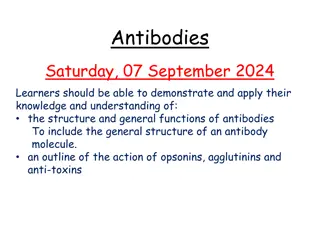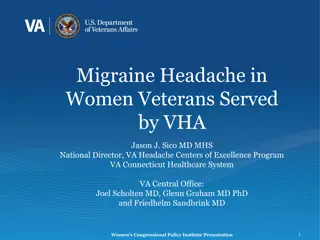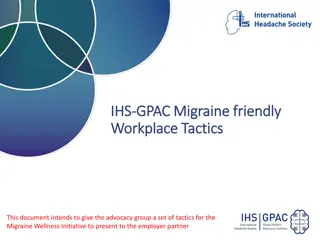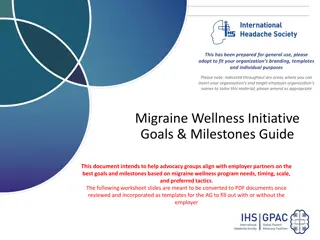Understanding Eligibility for Novel CGRP Monoclonal Antibodies in Migraine Patients
Characteristics of individuals eligible for novel CGRP monoclonal antibodies in migraine treatment were studied, revealing insights on access to preventive treatments for migraine patients. The American Headache Society highlights the importance of empirical research to enhance access to preventative treatments for migraines and shape future treatment strategies based on findings from the OVERCOME study.
- Migraine treatment
- CGRP monoclonal antibodies
- American Headache Society
- Preventive medication
- Empirical research
Download Presentation

Please find below an Image/Link to download the presentation.
The content on the website is provided AS IS for your information and personal use only. It may not be sold, licensed, or shared on other websites without obtaining consent from the author. Download presentation by click this link. If you encounter any issues during the download, it is possible that the publisher has removed the file from their server.
E N D
Presentation Transcript
SLIDE KIT THIS ACTIVITY IS SUPPORTED BY AN EDUCATIONAL GRANT FROM LILLY For further information concerning Lilly grant funding visit www.lillygrantoffice.com www.lillygrantoffice.com
SLIDE KIT Characteristics of Individuals with Migraine Who Are Eligible for Characteristics of Individuals with Migraine Who Are Eligible for Novel CGRP Monoclonal Antibodies: Results of the OVERCOME Novel CGRP Monoclonal Antibodies: Results of the OVERCOME Study. Study. Presented by Richard B. Lipton, MD Richard B. Lipton, MD Professor and Vice Chair of Neurology Professor and Vice Chair of Neurology Albert Einstein College of Medicine Albert Einstein College of Medicine Bronx, New York Bronx, New York Developed by Infomedica Medical Education& Information AHS Virtual Annual Scientific Meeting content is made available to an international audience through a licensing agreement between Infomedica and the American Headache Society. Infomedica is an independent medical education provider that delivers medical information to healthcare professionals through conference coverage and online educational programs and activities.
A M E R I C A N H E A D A C H E S O C I E T Y V I R T U A L A N N U A L S C I E N T I F I C M E E T I N G O F F I C I A L H I G H L I G H T S Key messages Access to migraine prevention treatment is influenced by sociodemographic factors and less than a third of people requiring treatment are receiving it. Empirical research is required to improve access to preventative treatments and to inform the revision of the AHS Position Statement. DEVELOPED BY
A M E R I C A N H E A D A C H E S O C I E T Y V I R T U A L A N N U A L S C I E N T I F I C M E E T I N G O F F I C I A L H I G H L I G H T S Background What do we already know about this topic? The American Headache Society s (AHS) position statement recommends migraine patients should experience the failure of two preventative medications before receiving CGRP (Calcitonin Gene-Related Peptide) targeted mAb (monoclonal antibody) treatment.1 The 2018 OVERCOME (ObserVational survey of the Epidemiology, tReatment and Care Of MigrainE) web-based survey provides a US representative sample (n=21,143) of the migraine healthcare landscape. DEVELOPED BY
A M E R I C A N H E A D A C H E S O C I E T Y V I R T U A L A N N U A L S C I E N T I F I C M E E T I N G O F F I C I A L H I G H L I G H T S Background How was this study conducted? A moderate-to-severe disability group (n=5,895) of migraine patients was selected from the OVERCOME survey using MHD (monthly headache days) 4 and MIDAS (Migraine Disability Assessment) 11. Subgroups were then created based upon patients being prescribed or recommended 0, 1, or 2 medications.2 Sociodemographic differences and migraine-related factors by the number of recommended migraine prevention medications were analyzed using a t-test (continuous variables) or Chi-square test (categorical variables).3-5 DEVELOPED BY
A M E R I C A N H E A D A C H E S O C I E T Y V I R T U A L A N N U A L S C I E N T I F I C M E E T I N G O F F I C I A L H I G H L I G H T S Findings What does this study add? 14% of patients used 2 preventative migraine medications and, therefore, would be immediately eligible for CGRP mAbs treatment. An additional 17.6% tried one preventative medication and would need to fail another to be eligible. Less than one-third of patients in need of a migraine prevention treatment have received one. Patients are more likely to take migraine prevention medication if they have health insurance, higher migraine-related symptoms, greater migraine-related disability, and are diagnosed. DEVELOPED BY
A M E R I C A N H E A D A C H E S O C I E T Y V I R T U A L A N N U A L S C I E N T I F I C M E E T I N G O F F I C I A L H I G H L I G H T S Perspectives How does this study impact clinical practice? Patterns associated with demographic, headache characteristics and healthcare- seeking behaviors can be used to inform strategy for improving access and outcomes to preventative treatments. Empirical research is required to determine the most cost-effective and cost- effective framework for sequencing preventative treatments, and to inform a revision of the AHS Position Statement. DEVELOPED BY
A M E R I C A N H E A D A C H E S O C I E T Y V I R T U A L A N N U A L S C I E N T I F I C M E E T I N G O F F I C I A L H I G H L I G H T S References 1. American Headache Society. The American Headache Society Position Statement on Integrating New Migraine Treatments Into Clinical Practice. Headache 2019;59:1-18. https://headachejournal.onlinelibrary.wiley.com/doi/full/10.1111/head.13456 2. Silberstein SD, et al. Evidence-based Guideline Update: Pharmacologic Treatment for Episodic Migraine Prevention in Adults: Report of the Quality Standards Subcommittee of the American Academy of Neurology and the American Headache Society. Neurology 2012;78:1337- 1345. https://n.neurology.org/content/78/17/1337 3. Lipton RB, et al. Cutaneous Allodynia in the Migraine Population. Annals of Neurology 2008;63:148-158. https://onlinelibrary.wiley.com/doi/abs/10.1002/ana.21211 4. Lipton RB, et al. Validity and Reliability of the Migraine-Treatment Optimization Questionnaire. Cephalalgia 2009;29:751-759. https://journals.sagepub.com/doi/10.1111/j.1468-2982.2008.01786.x 5. Stewart WF, et al. Development and Testing of the Migraine Disability Assessment (MIDAS) Questionnaire to Assess Headache-Related Disability. Neurology 2001;56(6 Supp 1):S20-28. https://n.neurology.org/content/56/suppl_1/S20 DEVELOPED BY


